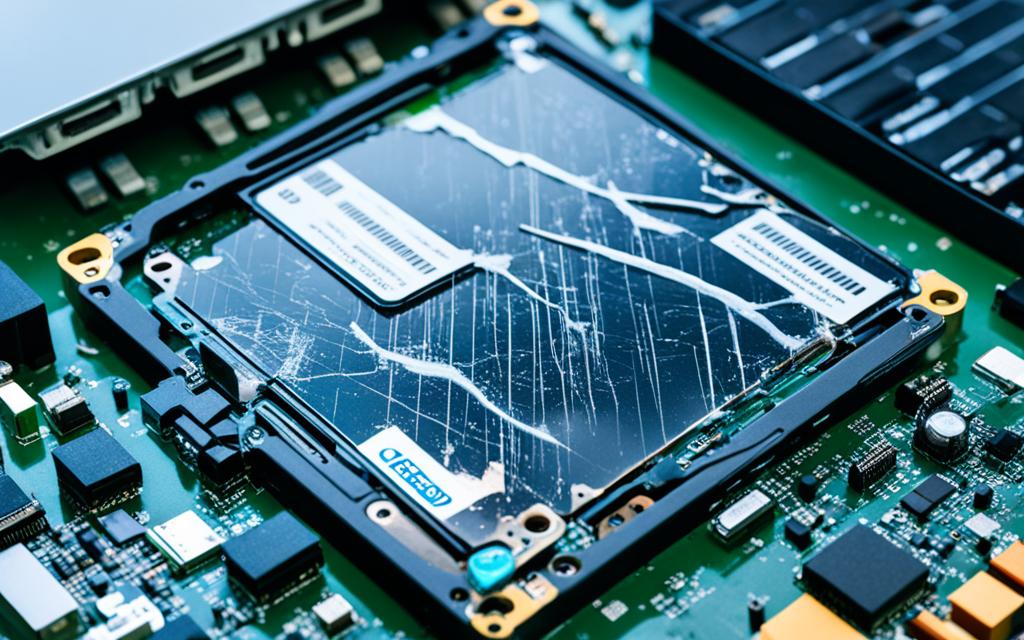Table of Contents
Solid State Drives (SSDs) offer impressive speed and reliability. But, they can fail suddenly. It’s crucial to know the signs of SSD failure to avoid major data loss. This includes priceless photos and vital documents. Unlike Hard Disk Drives (HDDs), SSDs don’t have moving parts. This usually makes them less likely to break down1. Yet, SSDs can still malfunction over time2.
Heat, power surges, and limited write cycles can all lower SSD performance. Knowing the signs of failure helps you protect your data.
Key Takeaways
- Recognising SSD failing symptoms can prevent critical data loss.
- SSDs are more durable than HDDs, yet they can still experience failure.
- Monitor for signs like file corruption and boot errors.
- Excessive heat and bad blocks indicate SSD distress.
- Regular health checks are essential for SSD longevity.
Understanding SSDs: A Brief Overview
Solid State Drives (SSDs) have changed how we store data. They are fast, efficient, and reliable. Thanks to their advanced technology, SSDs are far superior to older hard drives. They provide quick access to data, which is crucial for fast-paced tasks.
The Advantages of SSDs over HDDs
SSDs use less power, which means laptops last longer and desktops use less energy. They use flash memory, so they have no moving parts. This makes them tough and unlikely to get damaged by drops or bumps. Research shows SSDs can last 7 to 10 years, a big improvement over HDDs3.
Common Reasons for SSD Failure
However, SSDs can still fail. They have a limited number of read/write cycles. So, heavy use might wear them out. A study found SSDs had an average of 21 unsafe shutdowns. This can damage them and cause data loss4. Heat and power cuts also pose risks.
Signs of failure include file errors, freezing programs, slow computers, and crashes. If an SSD suddenly becomes read-only, it might soon fail4. Recognising these signs early can help you save your data by backing it up.
How to Tell If an SSD is Failing
It’s vital to know when an SSD might be failing to protect your data. You might see signs like slower read/write speeds. Paying attention early on helps avoid bigger problems later.
Slow Read and Write Speeds
A drop in how fast your computer reads and writes data is a warning. If your computer starts slowly or apps run slow, your SSD might be wearing out5. Using your SSD a lot, especially with heavy files, can wear it down quicker. Power issues can also slow it down, creating more problems5.
File System Errors and Access Issues
Having trouble opening files or getting errors is a bad sign. It can mean parts of your SSD are failing, like how old hard drives get bad sectors6. When these errors keep happening, it’s a sign to check your SSD more closely.
Frequent Crashes During Boot
SSDs that make your computer crash during startup are showing serious problems. These crashes mean your SSD might soon stop working altogether6. If your device suddenly can only read data, your SSD’s life may be coming to an end5. It’s important to keep an eye on your SSD and stay updated with its software to help it last longer.
Common Symptoms of a Failing SSD
Knowing when an SSD might fail helps protect important data. Watch out for bad blocks, read-only statuses, and overheating. By spotting these signs early, you can prevent losing valuable information.
Bad Blocks and Errors
Bad blocks on an SSD are a sure sign something is wrong. They make reading or writing files hard. This might lead to more errors and missing files or folders7.
Physical damage, too much use, and defects can cause bad blocks7. Also, wrong shutdowns might create file system errors, adding more bad blocks.
Unexpected Read-Only Status
If your SSD suddenly becomes read-only, it’s a red flag. This stops you from saving new data but lets you read files. It’s crucial to fix this quickly to avoid bigger problems8.
Overheating Issues
Too much heat is dangerous for SSDs. It shortens their life. Causes include lack of cooling or poor power supply. Keep an eye on temperatures, especially when using the disk a lot8.
Being aware of these signs helps keep your SSD in good shape. Regular checks and diagnostic tools are key for spotting problems early. This helps keep your computer in top condition to improve computer health.
Checking Your SSD’s Health
Keeping your SSD in good shape is key to its speed and long life. By checking its health regularly, you can spot problems early. This keeps your computer running smoothly and securely. There are special tools made just for SSDs that help you see how they’re doing.
Using Diagnostic Tools
Diagnostic tools are a great way to check your SSD’s health. CrystalDiskInfo, for example, tells you about “Power On Hours” and how much you’ve written to the SSD. This lets you understand how much you’ve used it over time. AIDA64 Extreme goes further by giving details on the SSD’s expected life span, how much data you’ve written in total, and “Power-On Time.”9 EaseUS Partition Master is easy to use and can quickly spot issues like bad sectors in just a few minutes10.
Manufacturer-Specific Tools
SSD makers often have their own tools for checking SSD health. Samsung Magician Software, for instance, works well with Samsung SSDs. It checks the drive’s condition, updates its software, and tests its speed. Seagate’s SeaTools offers quick tests to see if your drive passes or fails. These tests are fast and straightforward9.
Regular Monitoring Practices
Setting a schedule to monitor your SSD’s health is smart. It makes your data safer and your device more reliable. You can use tools like CHKDSK or Windows Properties to look for errors. Doing these checks often helps find issues early. It also reminds you to back up your important files regularly10.
Conclusion
Looking after your SSD is key for keeping your data safe in the long run. SSDs are quicker and more reliable than HDDs, with a lower failure rate of just 1.05% versus 6.21% for HDDs11. But, they’re not perfect. Signs of trouble like often crashing, being slow, or showing errors suggest a looming failure11. To protect your important data, it’s wise to do regular health checks and keep backups.
Using tools like DiskInternals Partition Recovery or other monitoring software helps track the health of your SSD12. Paying attention to your SSD’s condition helps with better maintenance. This care can make your SSD last 10 to 15 years under normal use13. Remember, losing data is much worse than the effort needed to maintain your SSD well.
In today’s digital world, keeping your data secure is critical. Mixing clever data protection with careful monitoring lowers the chance of serious failures. This lets users enjoy their SSDs to the fullest. For more advice on spotting SSD health issues and finding fixes, check out comprehensive resources.
FAQ
What are the common signs of SSD failure?
Signs your SSD might be failing include a drop in how quickly it reads and writes data. You might also have trouble getting to certain files because of file system errors. If your computer often crashes when it starts, it’s a warning your SSD could be close to breaking.
How can I tell if my SSD is failing?
Watch out for things like slow performance or trouble opening files. Crashes that come out of nowhere can also be a clue. If your SSD struggles with speed or if errors block file access, these are red flags it might fail soon.
What are the advantages of SSDs compared to HDDs?
SSDs have a lot going for them. They’re faster, use less power, and can take a knock better than HDDs. Since they don’t have moving parts, they’re less likely to break down. This means SSDs often last longer than HDDs.
What can cause an SSD to fail prematurely?
A few things can shorten an SSD’s life. Running out of write cycles, getting too hot, or sudden power shocks are common culprits. Knowing these reasons helps users avoid them and keep their SSDs working longer.
How can I check the health of my SSD?
You can use tools that check things like the SMART status to see how your SSD is doing. There are both third-party and official tools for checking up on your SSD’s health.
What tools are available for monitoring SSD performance?
Programs like Hard Disk Sentinel let you keep an eye on your SSD’s condition, including its temperature and overall health. Brands that make SSDs usually provide their own software for monitoring performance as well.
What does it mean if my SSD becomes read-only?
An SSD going read-only is a serious problem, stopping any new data from being saved. You can still open your files, but this issue usually needs quick action to stop data from getting lost.
How often should I conduct an SSD health check?
It’s important to regularly check on your SSD’s health. Doing health checks now and then is wise, especially if you spot signs it might not be working well. This helps make sure your SSD lasts as long as possible.
What steps can I take for data protection against SSD failure?
Keeping your data safe means backing it up often and doing regular SSD health checks. Being alert to signs of trouble can greatly lower the chance of losing your data.
Source Links
- https://www.minitool.com/backup-tips/how-to-tell-if-ssd-is-failing.html – How to Tell if SSD Is Failing? Check Failure Signs & What to Do?
- https://hdsentinel.com/blog/failing-ssd-symptoms – 8 Failing SSD Symptoms and What to Do to Save Your Data
- https://www.datarecovery.net/articles/common-symptoms-of-ssd-failure.aspx – Learn about the common symptoms of SSD failure and how you can prevent it – ACE Data Recovery Article
- https://www.makeuseof.com/tag/5-warning-signs-ssd-break-fail/ – 5 Warning Signs Your SSD Is About to Break Down and Fail
- https://www.stellarinfo.co.in/kb/warning-signs-of-ssd-failure.php – Top Warning Signs of SSD Failure and data loss from SSD
- https://www.thewindowsclub.com/how-to-tell-if-your-ssd-is-failing – Warning signs that tell if your SSD is failing in Windows 11/10
- https://www.techtarget.com/searchstorage/tip/4-causes-of-SSD-failure-and-how-to-deal-with-them – 7 causes of SSD failure and how to deal with them | TechTarget
- https://www.salvagedata.com/ssd-failures-common-causes-and-main-symptom/ – SSD Failures: Common Causes And Main Bad Symptoms – SalvageData
- https://www.tomshardware.com/how-to/check-ssd-health-windows-10-11 – How to Check SSD Health in Windows 10 and Windows 11
- https://www.easeus.com/partition-master/check-ssd-for-errors.html – 3 Efficient Ways to Check SSD for Errors on Windows 10/11
- https://www.szyunze.com/identifying-ssd-warning-signs-and-solutions-what-we-know/ – Identifying SSD Warning Signs and Solutions: What We Know
- https://recoverit.wondershare.com/harddrive-errors/why-ssd-fails-and-how-to-deal-with-it.html – SSD Failure: Symptoms, Reasons, and Fixes
- https://www.diskinternals.com/partition-recovery/how-to-know-ssd-dead/ – Is my SSD dead?








